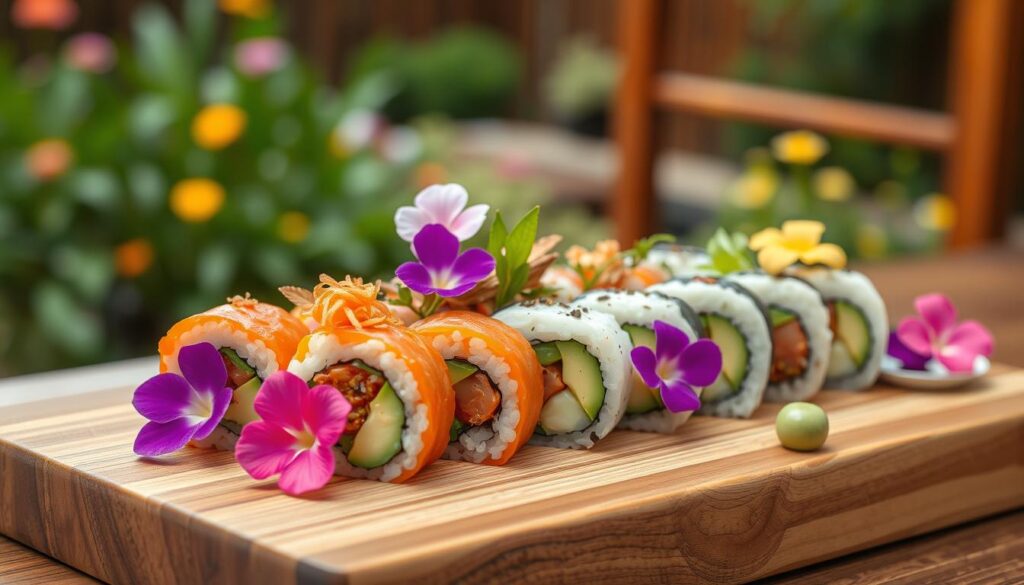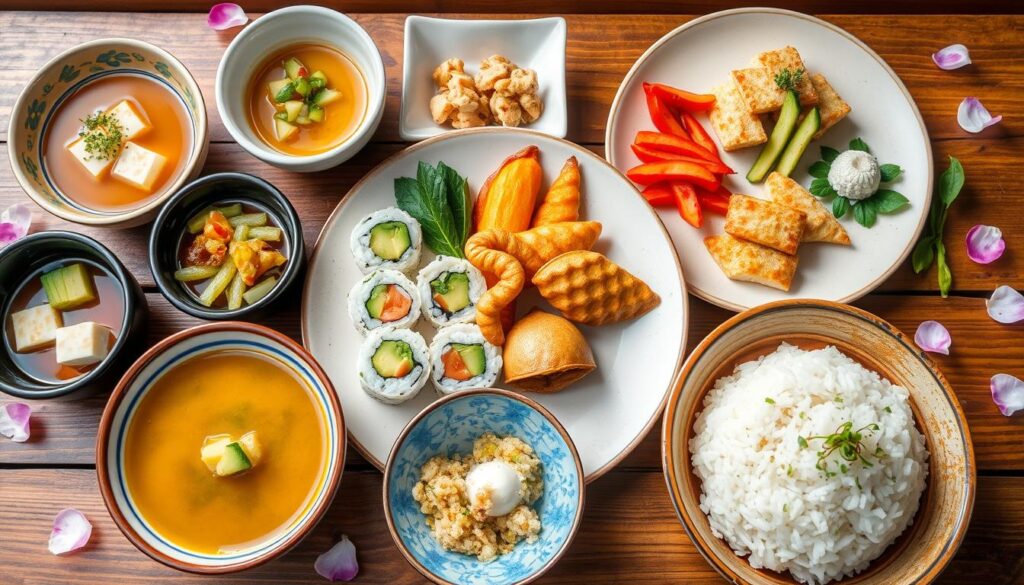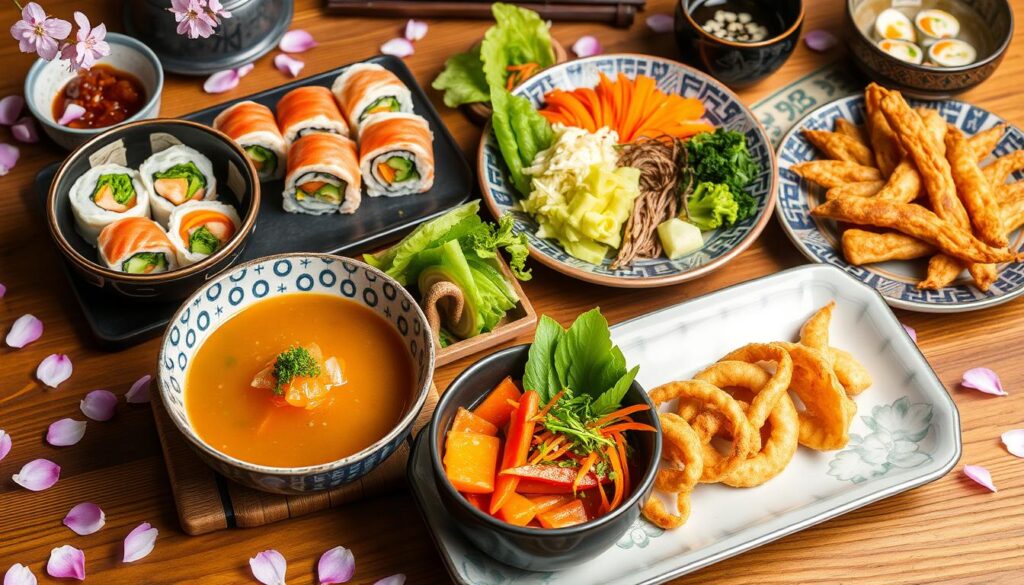Vegan food japan scene is amazing for vegans. It offers many plant-based dishes that show off Japan’s culture. Japan is known for seafood, but it also values plant-based foods because of Buddhism and Shintoism.
From old diets to today’s vegan and vegetarian food, Japan has a lot to offer. You can find real vegan experiences in Japan.
This guide will show you the best vegan food in Japan. You’ll see cities like Tokyo and Osaka, temples in Kyoto, and islands in Okinawa. It will help you find traditional Japanese food, new plant-based dishes, or a mix of both.
Key Takeaways
- Japan’s traditional cuisine has deep roots in plant-based foods, influenced by Buddhist and Shinto principles.
- Vegan travelers can enjoy a wide range of Japanese dishes, from bento boxes to sushi, with some cultural nuances to navigate.
- Major cities like Tokyo, Kyoto, and Osaka offer a growing number of vegan-friendly restaurants and options.
- Vegan food experiences in Japan range from street food tours to cooking classes, allowing you to immerse yourself in the local culture.
- Understanding common hidden animal ingredients and learning a few key Japanese phrases can help you make the most of your vegan dining experiences in Japan.
Understanding Japan’s Plant-Based Culinary Heritage
Japan’s food history is all about plants. The Edo period was mostly vegetarian. Buddhist and Shinto ideas also played big roles. They showed the value of meat-free dining osaka and dairy-free japanese meals.
The Edo Period and Traditional Diet
In the Edo period, Japan mostly ate plants. This was because of worries about trees and meat production. Buddhist teachings also helped make eating plants more common.
The saying “itadakimasu” shows thanks for all food. It’s said before eating, showing respect for all food sources.
Buddhist and Shinto Influences
Zen Buddhism came to Japan around A.D. 675. It led to a ban on meat. This created shojin ryori, a vegetarian temple food.
Shintoism also played a big role. It taught to respect nature and eat mindfully. This made Japan’s love for plant-based food even stronger.
The Meiji Era Transformation
The Meiji era changed Japan’s food ways in the late 19th century. Japan started eating more meat, thanks to Western influence. But, saying “itadakimasu” before meals still shows Japan’s respect for all food.
“Japan’s culinary history has strong plant-based foundations, with the Edo period’s predominantly vegetarian diet and the enduring influence of Buddhist and Shinto philosophies.”
Essential Japanese Vegan Dishes to Try
Discover the world of cruelty-free Japanese dishes and vegan sushi options. Japan’s food culture is rich in plant-based dishes. These are full of flavor and good for you.
The bento box is a must-try. It’s a mix of rice, veggies, and tasty treats. Vegetable sushi, with avocado and cucumber, is a great vegan choice. Inarizushi, tofu skin pouches, are also yummy.
Miso soup, a Japanese favorite, can be made vegan. Zaru soba and udon noodles are refreshing. Oyaki dumplings and Japanese curry are vegan too.
https://www.youtube.com/watch?v=nx2dVOvu-SU
Try vegan versions of tempura, ramen, and gyoza. Okonomiyaki, onigiri, natto, and koyadofu are also vegan. Shojin Ryori, Buddhist temple food, is all vegan.
In Tokyo or Kyoto, you’ll find lots of vegan Japanese food. Enjoy the flavors and textures of these dishes. Start a food adventure that’s unforgettable.
Navigating Traditional Japanese Restaurants as a Vegan
Exploring Japan as a vegan can be fun but tricky. You’ll find amazing tofu delicacies and buddhist vegetarian fare. Just know a few things to make your dining out smooth.
Common Hidden Animal Ingredients
In Japan, animal products sneak into many dishes. Dashi, a broth, and katsuobushi, dried fish flakes, are often used. They might be in sauces and soups.
Useful Japanese Phrases for Ordering
- “Kore wa beegan desu ka?” (Is this vegan?)
- “Watashi wa niku to sakana, tamago, nyuuseihin, hachimitsu ga taberaremasen” (I don’t eat meat, fish, eggs, dairy products, or honey)
Cultural Etiquette Tips
Being polite is key in Japan’s traditional restaurants. Say thank you for any special dishes. Showing respect makes your meal better.
“The key to enjoying vegan dining in Japan is to approach it with an open mind, a willingness to explore, and a deep respect for the country’s rich culinary heritage.” – Vegan Travel Expert, Akiko Ueno
With some prep and cultural savvy, you can dive into Japan’s vegan delights. Knowing about traditional food and asking nicely lets you enjoy Japan’s flavors as a vegan.
Shojin Ryori: The Art of Buddhist Temple Cuisine
Explore the world of macrobiotic cuisine japan with Shojin Ryori. It’s a vegan Buddhist food that’s been made for centuries. This food is served in temples and special restaurants, showing how great vegan japanese food can be.
Shojin Ryori uses fresh, local ingredients for its dishes. It’s made in small, beautiful courses. The food is made to give the body what it needs, making meals healthy and tasty.
- Shojin Ryori is all plants, like veggies, grains, seaweed, and fruit. It follows Buddhist ways.
- Important foods in Shojin Ryori include Koya-dofu, Natto, and Abura-age. Also, Fu, Konnyaku, Kabocha, Fuki, Nanohana, Dashi stock, Mirin, and Miso.
- The “ichi ju san sai” rule is followed. This means one soup, three sides, rice, and pickles.
Trying Shojin Ryori in Kyoto is a must for real macrobiotic cuisine japan fans. You need to book at top Shojin Ryori places. There, you’ll enjoy a special meal that shows off vegan japanese food‘s beauty and taste.
“Shojin Ryori is a true work of art, where each ingredient is treated with the utmost care and respect, creating a dining experience that nourishes both the body and the soul.”
Whether you love vegan japanese food or are new to macrobiotic cuisine japan, Shojin Ryori is a unique journey. Get ready for amazing tastes, beautiful dishes, and the deep culture of this plant-based food.
Vegan Food Japan: Where to Find Plant-Based Options
Exploring Japan’s vegan food scene is fun for plant-based travelers. You’ll find many vegan restaurants and markets in Tokyo and Kyoto. These places offer tasty, kind food choices.
Major Cities Guide
Tokyo, Kyoto, Osaka, and Hiroshima have lots of vegan spots. Tokyo has hundreds of vegan restaurants. You can find everything from simple meals to fancy plant-based dishes.
In Asakusa, Tokyo, you can get a lunch box for 3,450 to 5,000 yen. It’s a great way to enjoy a meal in the middle of the day.
Local Markets and Shops
Local markets and shops are full of vegan treasures. In Tokyo, places like Nissin World Delicatessen and National Azabu have vegan imports. Natural Lawson stores also have vegan snacks.
Convenience Store Finds
Japan’s convenience stores, or “konbini,” have vegan options. You can find onigiri, mochi, and vegan cookies. HappyCow and Google Maps help find vegan places in Japan.
Japan is getting more vegan-friendly. Tokyo’s vegan scene is especially growing. There are many new vegan restaurants and cafes.
Traveling in Japan, you’ll find many vegan options. Enjoy the food in Tokyo, Kyoto, or anywhere else. Japan’s vegan food is amazing.
Modern Japanese Vegan Innovations
Japan’s vegan food scene is changing fast. New plant-based versions of Japanese dishes are popping up. This includes vegan sushi options and vegan Japanese dishes. More people want food that’s kind to animals and good for the planet.
Vegan ramen, gyoza, and other Japanese favorites are now available. Restaurants use soy, mushrooms, and seitan to make them. These dishes are tasty and show how Japanese food can be vegan.
| Plant-Based Innovations | Traditional Japanese Dishes |
|---|---|
| Vegan Ramen | Tonkotsu Ramen |
| Vegan Gyoza | Pork Gyoza |
| Vegan Sushi | Nigiri Sushi |
Japan’s vegan food scene is also trying new things. It’s mixing Japanese tastes with global vegan ideas. This makes for exciting dishes that are good for you and the planet.
“The future of Japanese cuisine is plant-based, and we’re excited to be at the forefront of this culinary revolution.” – Chef Takeshi Miyamoto, Vegan Gourmet Restaurant
More people want vegan and vegetarian food. Japan’s food industry is stepping up. With new products and menus, Japan’s vegan scene is changing how we see Japanese food.

Street Food and Snack Guide for Vegans
Exploring Japanese street food and snacks as a vegan is fun. You’ll find many vegan treats and street eats to enjoy.
Traditional Vegan Treats
Japan has many vegan street food classics. Dango, chewy rice dumplings, are often vegan. They come in flavors like sweet soy sauce or kinako.
Warabi mochi, a jelly-like snack, is also vegan. It’s made from bracken starch. Sweet potato snacks like imo karaage and yakiimo are tasty vegan options.
Modern Plant-Based Street Eats
New vegan street food is popping up in Japan. Taiyaki, a fish-shaped pastry, now has vegan versions. They use soy-based dough and fillings like red bean paste.
Plant-based takoyaki is another vegan delight. It’s a snack that used to have octopus but now has mushrooms or soy.
| Traditional Vegan Treats | Modern Plant-Based Street Eats |
|---|---|
|
|
Japan’s food scene is great for vegans. You can try traditional treats or new vegan street eats.
Regional Vegan Specialties Across Japan
Start a tasty trip across Japan. You’ll find many vegan treats. Kyoto is all about tofu, while Osaka has vegan okonomiyaki. Each place has its own vegan foods.
In Kyoto, try the amazing tofu and yuba dishes. In Osaka, enjoy vegan okonomiyaki. Nagano has yummy soba noodles and oyaki dumplings, all without meat.
Okinawa is special with its vegan foods. It’s influenced by the island’s history and nature. Here, you’ll find many tofu dishes loved by locals.
Japan’s vegan foods are exciting for everyone. They will make your taste buds happy and teach you about Japan’s vegan traditions.
| Region | Vegan Specialties |
|---|---|
| Kyoto | Tofu dishes, yuba (tofu skin) |
| Osaka | Vegan okonomiyaki |
| Nagano | Soba noodles, oyaki dumplings |
| Okinawa | Plant-based dishes influenced by local culinary heritage |
Explore Japan’s vegan food world. You’ll find both old and new vegan dishes. They will make you happy and healthy.

Plant-Based Dining in Japanese Homes
Vegan dining in Japan is more than just eating out. Many Japanese homes welcome guests with plant-based dishes. This lets you dive into the heart of macrobiotic cuisine and Buddhist vegetarian food.
Home-cooked meals often include rice, veggies, tofu, and miso soup. Cooking classes and home-stays teach you about vegan Japanese cooking. These settings show you the daily life of Japanese families and their cooking traditions.
Want to learn sushi-making or explore vegan Japanese food? Talking with local hosts deepens your understanding and love for this food culture. With an open mind, you’ll find the kindness and welcome of Japanese plant-based dining.


A Life-Changing Experience with This Weight Loss Supplement (Nagano Tonic)
I’ve always struggled with finding a weight loss solution that actually works for me. Like many, I’ve tried numerous diets, exercise routines, and supplements over the years—some worked for a short time, but nothing ever gave me long-term results. That was until I decided to try the weight loss supplement I found : Link to the Supplement.
From the moment I started using it, I noticed a difference. Not only did I feel more energized, but my cravings also became more manageable. The best part? I started seeing results much quicker than I anticipated! Over the course of just a few weeks, I noticed a significant reduction in belly fat and overall weight loss that I hadn’t been able to achieve before.
What makes this supplement stand out from all the others I’ve tried is how it supports me in my daily routine without any jitters or energy crashes. I’m able to stay focused and motivated, which has made it easier to stay on track with my diet and exercise plan.
This product truly exceeded my expectations, and I feel more confident and healthier than ever before. If you’re struggling with your weight loss journey like I was, I highly recommend giving this supplement a try. It’s been a game-changer for me, and I’m sure it can work wonders for you too!
Contant Them on email .. tonicnagano50@gmail.com
I’ve tried so many weight loss products over the years, but nothing worked like this supplement! Since I started using it, I’ve noticed a big difference in my energy levels and appetite control. In just a few weeks, I’ve lost weight and feel so much better. It’s been easy to stick with, and the results speak for themselves. Highly recommend this to anyone looking to make a real change!
wasn’t sure what to expect, but this weight loss supplement has really impressed me! After just a few weeks of use, I’ve already dropped a few pounds and feel more motivated to stay active. It’s helped curb my cravings and boosted my energy throughout the day. I’m excited to keep going and see even better results. Definitely worth trying!
Reach them on tonicnagano50@gmail.com
I was skeptical at first, but this supplement has truly made a difference in my weight loss journey. I’ve lost weight without feeling deprived or sluggish. My cravings are under control, and I feel more confident in my body. It’s easy to incorporate into my daily routine, and the results speak for themselves. I’m so glad I gave it a try!
Thanks David, i do use the link to make my purchase. you can get too here http://surl.li/iasppy
I’ve tried so many weight loss products, but this one has been by far the most effective. In just a few weeks, I’ve noticed a visible difference in my body and energy levels. It’s helped me stay on track without the constant hunger pangs and cravings. I’m really happy with my progress and can’t wait to see where I’ll be in another month!
This Nagano Tonic has been amazing! In just a few weeks, I’ve lost weight, feel more energized, and my cravings are under control. Highly recommend it!
Thats the link to purchase http://surl.li/iasppy